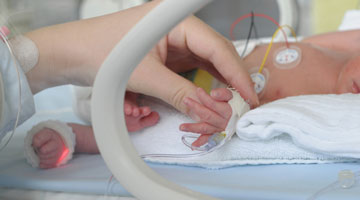Preterm Labor
Pre-term Labor – The Risks & Challenges
What is Pre-Term Labor? As the word suggests, pre-term labor or premature labor means that your contractions start ahead of your calculated due date, and/or your water breaks and the baby is born ahead of schedule; in some cases, it could also mean that some of the organs, such as the lungs, may not be fully developed. If you experience contractions prior to your 37th week of pregnancy, this is a good indication of pre-term labor.
Although many “premature babies” born before 37 weeks are born healthy, the last few weeks of pregnancy help the lungs and other organs finish developing properly and help the baby gain sufficient birth weight. Preterm labor may also be induced by your physician if baby shows signs of distress, or there's risk of complications, such as preeclampsia - a condition causing blood vessels to narrow, reducing blood flow to the uterus.
Spontaneous preterm births
Spontaneous preterm labor and births can also occur. This will happen if you experience PPROM (Premature Rupture of Membranes) and your water breaks or
... Read more
your cervix dilates prematurely (cervical insufficiency). Contractions don’t necessarily accompany this condition.
Concerns, risks, symptoms, & challenges of preterm labor
As a result, preeclampsia may produce low amounts of amniotic fluid, as well as placenta abruption (premature separation of the placenta from the uterine wall). This condition can also affect your body, and your organs, such as your kidneys, liver and brain. The earlier it appears and the more severe the condition, the greater the risks. Your physician may choose to do a Caesarean if either you and/or your baby are in danger, which may lead to other issues associated with premature births
One of the concerns is that there are about 1/3 more babies being born prematurely due to multiple births from fertility treatments—they have a tendency to produce premature births. There is some evidence indicating that women choosing to postpone motherhood face the risk of multiple conceptions; this also increases with age.
Risks of preterm labor & birth
Several health problems have been associated with preterm birth, especially if it occurs several weeks prior to the due date. The more developed a baby is, the better their chances of not developing health issues.
Some common health issues for preterm babies: i.e. they have difficulties regulating their body temperature, may experience difficulty feeding and develop jaundice. They may also develop breathing problems, and or run a high risk for brain hemorrhage. Other organs may be affected as well. Cerebral palsy, vision and hearing impairment, developmental problems and chronic lung disease have also been linked to severely premature babies, born prior to 34 weeks. Most preterm babies are born between 34-37 weeks.
What to do if you are in preterm labor
The longer the pregnancy goes, the better for you and your baby. However, if you begin to show signs of preterm labor, and unless there is a certain urgency for delivery, your physician may be able to delay your delivery. By administering corticosteroids to your baby, this accelerates the development of the lungs and other organs, increasing the chances for survival and abating some of the risks discussed. NICU (Neonatal Intensive Care Units) all over the world now have the most advanced neonatal intensive care technology to take care of your premature baby, providing the best chance for survival.
Some women experience Braxton Hicks contractions throughout their pregnancy-these are different from preterm labor. Braxton Hicks contractions are virtually painless but may become difficult to distinguish for actual preterm labor. However, as you get closer to your due date, you will begin to experience contractions of greater intensity and discomfort as they become more frequent, causing your cervix to efface and start to dilate. If you are unsure, call your physician or caregiver.
If you believe you are in preterm labor and are within a few weeks of your due date, the March of Dimes suggests try ing these measures:
- Change your activity or position.
- Walking may provide relief
- Resting may ease contractions (True labor contractions will persist and progress regardless of what you do.)
- Take a warm bath to help your body relax
- Dehydration may trigger contractions- drink plenty of water to stay hydrated
- Practice breathing exercises--slow, deep breathing.
- Practice the pain-management techniques from the childbirth prep classes
When to call your caregiver or physician
If you are less than 37 weeks along, and you are experiencing painful contractions, call your physician immediately. Below are is a list of some of the most typical symptoms:
- Abdominal pain
- Menstrual-like cramping
- More than four contractions in one hour
- Any vaginal bleeding or spotting
- An increase in vaginal discharge
- More pressure in the pelvic area (a feeling that your baby's pushing down)
- Low back pain, especially if it's dull or rhythmic, or you didn't previously have back pain
Reducing your Risk
Although preterm labor can affect any pregnant woman, those that are more at risk tend to have medical risk factors or daily risk factors that increases their chances of a premature birth.
According to several medical studies, there are some medical risk factors that contribute to preterm labor and premature birth, such as:
- Poor prenatal care
- Being overweight or underweight
- Not enough weight gain during pregnancy
- Pre-existing health conditions, i.e. high blood pressure, preeclampsia, or diabetes
- Sexually transmitted diseases (STDs) or other infections
- Preterm premature rupture of the membranes (PPROM)
- Fertility treatment pregnancy
- Carrying a baby with known birth defects, i.e. spina bifida or congenital heart defects
- Not waiting long enough between pregnancies (18 months is suggested)
- Premature births in the family history
Other Contributing Risk Factors
- Bad personal habits, i.e. smoking, drugs, alcohol
- Stresses in personal life
- Domestic violence.
- Working long hours
- Environmental factors
Meds used for preterm labor
If you have gone into preterm labor, your physician can administer the following to minimize the risks:
1. ACS (Antenatal corticosteroids). Speed up lung development, reduce certain post-partum health issues
2. Antibiotics. If you have preterm premature rupture of membranes (also called PPROM), you may need antibiotics to prevent infections
3. Tocolytics. These slow or stop labor contractions for a few days
4. Cerclage. A stitch in the cervix to keep it closed
5. Bed rest – to help you relax
















